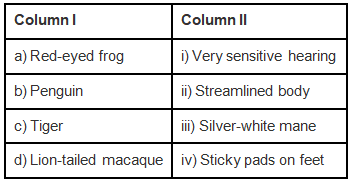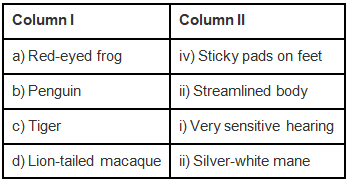NCERT Exemplar Solutions: Weather, Climate & Adaptations of Animals to Climate | Science Olympiad Class 7 PDF Download
Multiple Choice Questions
Q.1. The maximum and minimum temperature displayed daily in the weather bulletin refer to the –
(a) highest day temperature and lowest night temperature of the day.
(b) highest day temperature and highest night temperature of the month.
(c) the temperature recorded at 12 noon and at midnight (00.00 hrs).
(d) the average highest temperature of the day and the average lowest temperature of night.
Ans: a
Explanation:
Highest day temperature occurs in the afternoon and lowest temperature of the day occurs in the dawn.
Q.2. Out of the given definitions, which is the most appropriate definition of climate?
(a) Changes in weather conditions in a year.
(b) The average weather pattern for many years.
(c) Change in the weather pattern in a few years.
(d) Weather conditions during summer.
Ans: b
Explanation:
Climate is the weather conditions of an area prevailing for a long period of time.
Q.3. Which of the following briefly describes the desert climate?
(a) Hot and humid
(b) Dry and humid
(c) Hot and dry
(d) Hot and wet
Ans: c
Explanation:
In Desert temperature is high during most parts of the year and the desert receives very less rainfall hence the climate in the desert will be hot and dry.
Q.4. Paheli went to a wildlife sanctuary where she saw dense vegetation of trees, shrubs, herbs and also a variety of animals like monkeys, birds, elephants, snakes, frogs, etc. The most likely location of this sanctuary is in the –
(a) temperate region
(b) tropical region
(c) polar region
(d) coastal region
Ans: b
Explanation:
Wildlife sanctuary which Paheli went was of a tropical region because this region has a favorable condition to support a wide variety of living organisms. Remaining options like temperate region, polar and coastal region will not support a variety of wildlife as a tropical region.
Q.5. Given below are some adaptive features of animals:
(i) A layer of fat under the skin
(ii) Long, curved and sharp claws
(iii) Slippery body
(iv) Thick white fur
Which of them are the adaptive features of a polar bear?
(a) (i) only
(b) (i) and (ii) only
(c) (i), (ii) and (iii) only
(d) (i), (ii), and (iv) only
Ans: d
Explanation:
To live in an extremely cold climate, the polar bear has many adaptations, such as:
(a) The layer of fat under the skin for insulation.
(b) Long curved and sharp claws to walk and run on slippery ice.
(c) Thick white fur. White colour protects it from predators and thick layer keep it warm.
(d) Other features are rounded body, small ears and a strong sense of smell.
Q.6. Which of the following statement is incorrect for penguins?
(a) They huddle together
(b) They cannot swim
(c) They have webbed feet
(d) They have streamlined body
Ans: b
Explanation:
Penguin is white and merges well with the white background. It has a thick skin and a lot of fat to protect it from cold. Penguins huddled together do to keep themselves warm. Like polar bears, penguins are also good swimmers. Their bodies are streamlined and their feet have webs, making them good swimmers.
Q.7. Read the following environmental conditions of tropical rain forests.
(i) A hot and humid climate
(ii) Unequal lengths of day and night
(iii) Abundant rainfall
(iv) Abundant light and moisture
Identify the conditions from the above list that are responsible for the presence of large number of plants and animals in tropical rain forests.
(a) (i) and (ii)
(b) (i) and (iii)
(c) (i), (iii) and (iv)
(d) (ii) and (iv)
Ans: c
Explanation:
The tropical region has generally a hot climate because of its location around the equator. Even in the coldest month, the temperature is generally higher than about 15°C. During hot summers, the temperature may cross 40°C. Days and nights are almost equal in length throughout the year. These regions get plenty of rainfall. Because of these reasons tropical rain forests support a large number of plants and animals.
Q.8. The coldest region on earth is the –
(a) polar region
(b) tropical region
(c) temperate region
(d) coastal region
Ans: a
Explanation:
Polar regions are covered with snow and it is very cold for the most part of the year. For six months the sun does not set at the poles while for the other six months the sun does not rise. In winters, the temperature can be as low as –37°C.
Q.9. Choose the odd one from the following options :
(a) A thick layer of fat under the skin
(b) White fur
(c) Long grasping tail
(d) Wide and large feet with sharp claws
Ans: c
Explanation:
The long grasping tail is the adaptation found in animals of the tropical region whereas others option gives adaptations of animals of the polar region.
Very Short Answer Questions
Q.1. “A fish dies when taken out of water whereas a wall lizard will die if kept underwater.” Mention the term used to describe such abilities that allow fish and lizard to survive in their respective habitats.
Ans: Adaptation
Q.2. Give one example of an animal that can live both in water and on land.
Ans: Frog
Q.3. State whether the following statements are True or False. Correct the false statements.
(a) It is easy to predict the weather rather than climate.
(b) Since very few preys are available, the polar bear does not need to have a strong sense of smell.
(c) Penguins stick together to fight the cold polar climate.
(d) Tropical rain forests are cool and humid throughout the year because of heavy rains all the time.
Ans:
a) False- It is easy to predict the climate rather than the weather.
b) False- polar bear needs to have a strong sense of smell.
c) True
d) False- Tropical rain forests are hot and humid throughout the year because they are located near the equator.
Q.4. Unscramble the following words using the hints given against them.
MATLICE (Hint: weather pattern in a region over a period of time)
AROPL (Hint: coolest region on earth)
TREHMEOMRET (Hint: used to measure temperature)
UHIDYTMI (Hint: feature of weather)
Ans:
(i) Climate
(ii) Polar
(iii) Thermometer
(iv) Humidity
Short Answer Questions
Q.1. Match the animals mentioned in Column I with their characteristic features given in Column II.

Ans:

Q.2. Why is it difficult to predict the weather of a place while it is easy to predict its climate?
Ans: Because weather can vary over a short period of time whereas climate as it is the average weather pattern taken over a long time.
Q.3. Name two animals each that live in Polar region and Tropical rain forests.
Ans:
- Polar region- Polar bear and Penguins
- Tropical rain forests- rain deer, tiger
Q.4. Write two common adaptive features of a polar bear which help in keeping it warm.
Ans:
(a) A layer of fat under the skin for insulation.
(b) Long curved and sharp claws to walk and run on slippery ice.
Q.5. Mention two adaptive features of penguin that help it in swimming
Ans:
Their bodies are streamlined and their feet have webs, making them good swimmers.
Q.6. Differentiate between:
(i) Weather and climate
(ii) Humidity and rainfall
(iii) Climates of the polar region and tropical rain forest
(iv) Maximum and minimum temperatures of the day
Ans:




Long Answer Questions
Q.1. Fill in the blanks in the paragraph given below.
The weather of a place is the day-to-day condition of the a) with respect to b) , c) , d), e) speed at that place, while climate is the f) weather pattern has taken over many years.
Ans:The weather of a place is the day-to-day condition of the a) atmosphere with respect to b) Temperature, c) Humidity, d) rainfall, e) wind speed at that place, while climate is the f) average weather pattern has taken over many years.
Q.2. Given below is a list of climatic conditions and some examples of animals. Read them carefully and place the items in the relevant columns as shown.
Penguin, Gorilla, Monkey, Reindeer, Assam, Greenland, Sun does not rise for six months, Hot and humid climate, Days and nights are almost equal in length throughout the year, Winter temperature around –37°C, Western Ghats

Ans:

|
53 videos|152 docs|55 tests
|
FAQs on NCERT Exemplar Solutions: Weather, Climate & Adaptations of Animals to Climate - Science Olympiad Class 7
| 1. What is weather and how is it different from climate? |  |
| 2. How do animals adapt to different climates? |  |
| 3. What are some examples of animals that are well adapted to cold climates? |  |
| 4. How does climate affect the distribution of animals on Earth? |  |
| 5. How do animals adapt to survive in hot climates? |  |





















